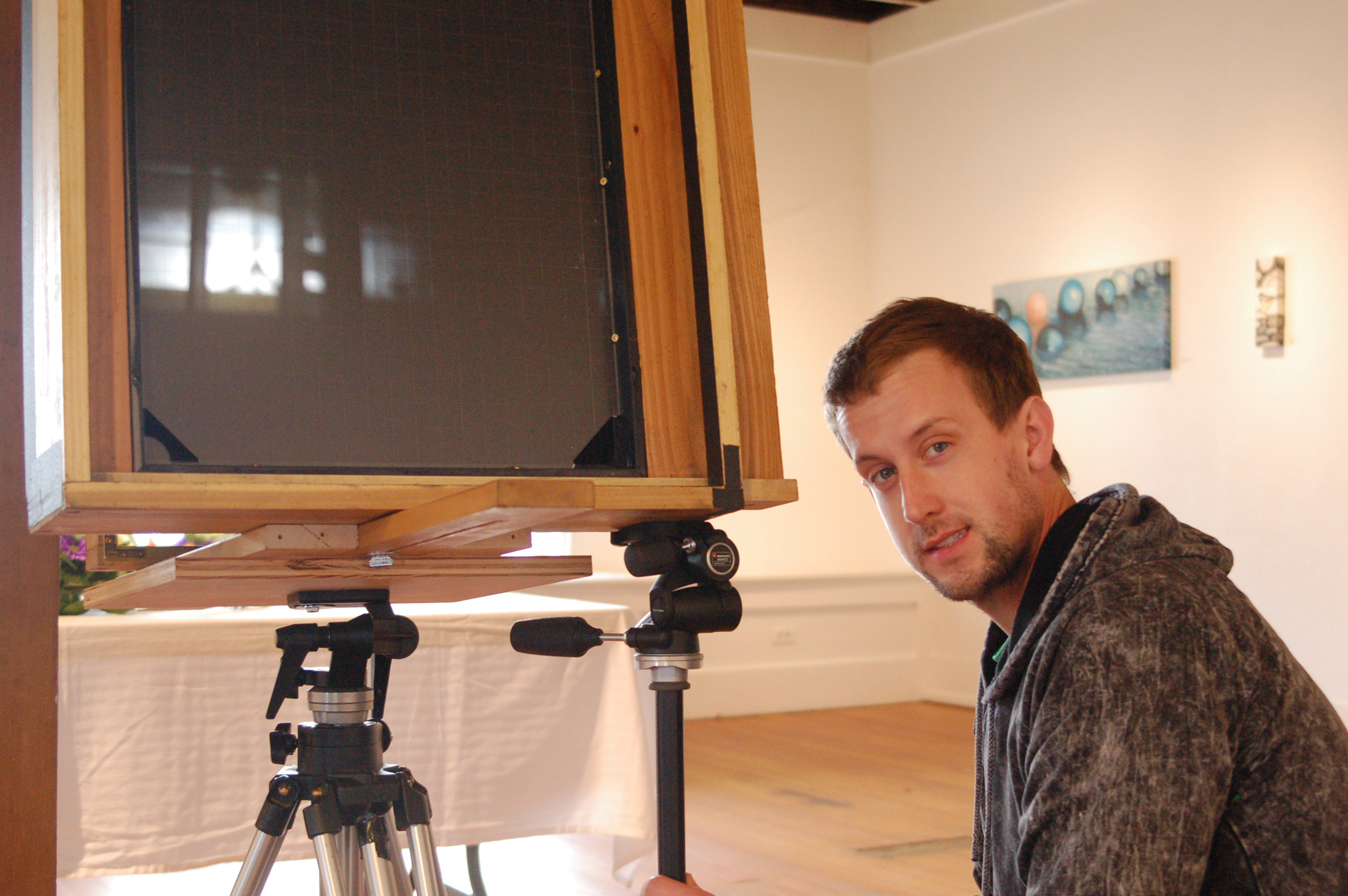In the days of cell phone and digital cameras, where applications like Hipstamatic and Instagram create photo effects of the 1950s, Fairbanks photographer Adam Ottavi has gone back even further in his exploration of historic photography.
This is not your father’s photography or even your grandfather’s photography. Forget 35mm film and Brownie cameras. For an artist’s residency at Bunnell Street Arts Center this month, Ottavi uses a photographic technique more than 160 years old, the wet-plate collodion process — a technology so old that pioneer photojournalist Mathew Brady used it in his images of the Civil War. President Abraham Lincoln, one of the first U.S. presidents widely photographed, had photos made by Brady using the collodion process.
Don’t think quick, fast and cheap. Each 16-inch-by-20-inch plate must be handmade with expensive chemicals, like $300 for a jar of silver nitrate powder. Because the plate degrades quickly, the photo must be taken within minutes of preparing the plate. The plate itself is the finished art work, with images of modern subjects that look antique.
“I love the fact that they’re original, unique and fragile photographs,” Ottavi said. “I get one print a day. To slow down like that feels brilliant.”
During his residency, Ottavi stays at the Old Town Bed & Breakfast upstairs from Bunnell. His project involves taking a series of portraits of Homer people, landscapes and other images which will be exhibited in a show on May 3 at Bunnell.
Ottavi had a camera made just for this residency. Except for the modern Nikon lens, the big, boxy camera looks like something out of the 19th century, complete with black sheet to fold over his head so Ottavi can view a dim image on a focusing screen.
Ottavi, 33, grew up in Dubuque, Iowa, and got his bachelor of fine arts at Columbia College in Chicago. He came up to Alaska for a visit, and after a few years in the Lower 48, returned to Fairbanks, where he got his master of fine arts at the University of Alaska Fairbanks. He studied the wet-plate collodion process with Frances Scully and Mark Osterman in Rochester, N.Y. Osterman is a photographic process historian at George Eastman House International Museum of Photography & Film and Scully an artist and teacher.
Like film photography, the collodion process and camera uses the same principle. Through a lens, project an image onto light-sensitive chemicals adhered to a glass plate or plastic film.
The chemicals react to light and, when developed, create a negative. Instead of buying manufactured film, though, Ottavi creates each plate in a darkroom in the basement of Bunnell.
The collodion of the process is a viscous material poured on to the thin plates. Ottavi inserts the plate into a lightproof box that has silver nitrate powder in it. The powder sticks to the collodion. At the camera, Ottavi focuses it on the subject, looking at the image projected upside down on a frosted glass plate. He then slides the plate into the camera, pulls it out of its case and exposes it for about 15 seconds by opening up the lens cap. The plate goes back into its case and is taken into the darkroom to be developed and fixed in chemicals.
The finished product is an image exposed and developed on the collodion film stuck to the plate. Held up to light it looks like a negative, but with a dark piece of paper behind it, looks like a positive image. Ottavi had frames made to hold and display the exposed plates. Considering all the steps in the process and the fragility of the chemicals and plates, it seems like a miracle that Ottavi gets any images at all.
“There are so many factors, so many variables that could go wrong, it’s best to roll with it,” he said.
For example, at 15-second exposures, the person being photographed has to stay still — the reason why in 19th century photographs no one smiles. Ottavi has a chair leaning against a wall in a studio, also in the Bunnell basement.
“It’s this meditative lesson,” he said of posing for a portrait. “It’s about being still versus holding still.”
Collodion plates also need warmth and light, something Ottavi found out when he tried to take photographs in December in Fairbanks. His images came out fogged. He finally figured out that 19th century photographers took images in the middle of the day, when the sunlight was strongest, and he needed a certain amount of ultraviolet light.
“When I figured it out, I had to chill and wait for spring,” he said.
On the other hand, Alaska’s summer light, with strong light for almost 18 hours, is perfect for the process, he said.
Although individual art, Ottavi acknowledges the community support of his work.
“It’s one person here on the show, but it’s the efforts of a lot of people,” Ottavi said.
There’s the residency itself, paid for by a $10,000 National Endowment for the Arts grant to Bunnell that will fund five artist residencies this year, including a $1,000 stipend to each artist, said Bunnell director Asia Freeman. Ottavi also received a $5,000 Rasmuson Foundation project grant. Fairbanks woodworkers also made the camera, frames and drying racks.
For more on Ottavi’s work, including his photographs, visit www.adamottavi.com.


